2014 MERCEDES-BENZ CLS SHOOTING BRAKE spare tire
[x] Cancel search: spare tirePage 14 of 417
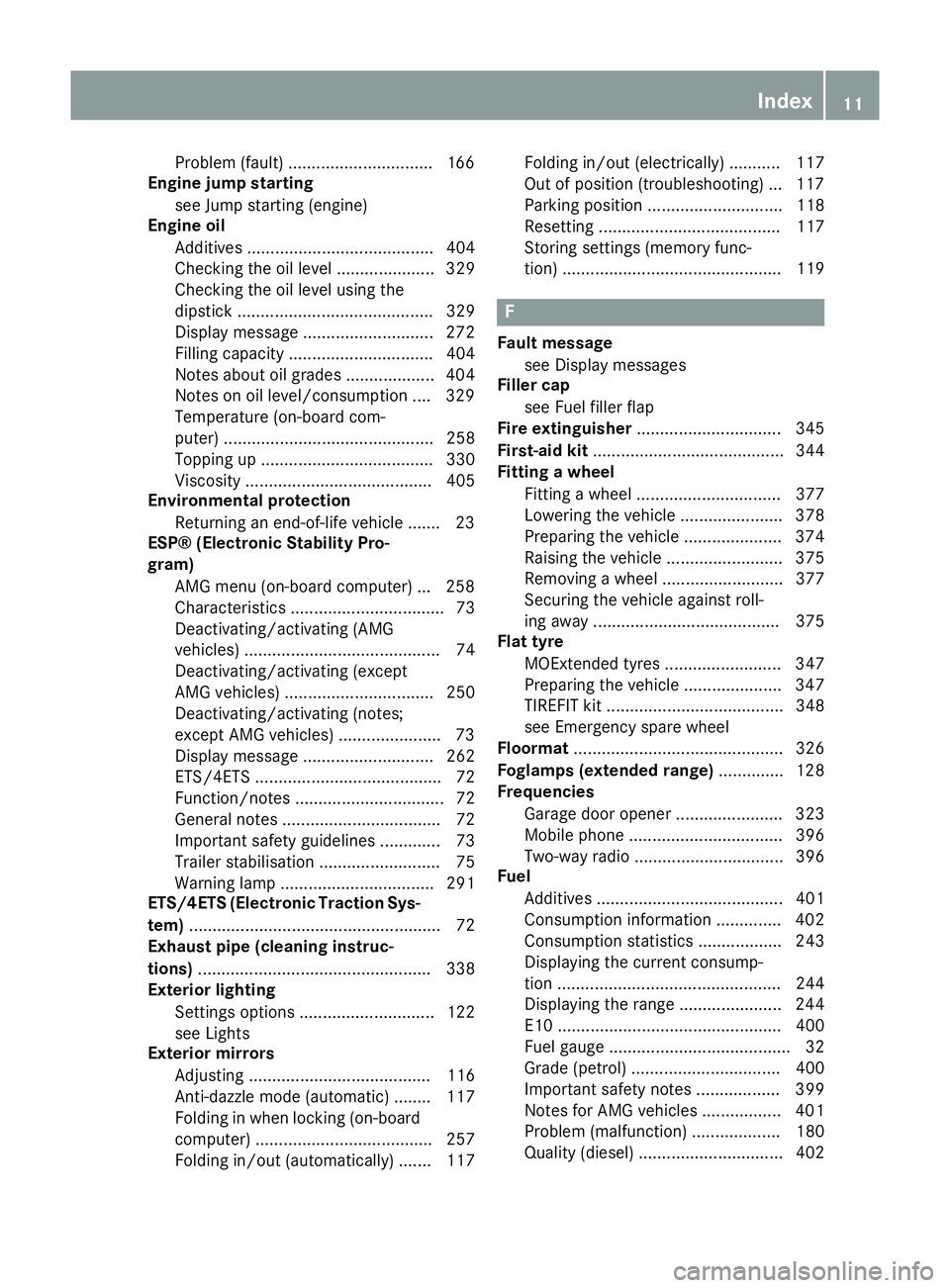
Problem (fault) ...............................1
66
Engine jump starting
see Jump starting (engine)
Engine oil
Additives ........................................ 404
Checking the oil level ..................... 329
Checking the oil level using the
dipstick .......................................... 329
Display message ............................ 272
Filling capacity ............................... 404
Notes about oil grades ................... 404
Notes on oil level/consumption .... 329
Temperature (on-board com-
puter) ............................................. 258
Topping up ..................................... 330
Viscosity ........................................ 405
Environmental protection
Returning an end-of-life vehicle ....... 23
ESP® (Electronic Stability Pro-
gram)
AMG menu (on-board computer) ... 258
Characteristics ................................. 73
Deactivating/activating (AMG
vehicles) .......................................... 74
Deactivating/activating (except
AMG vehicles) ................................ 250
Deactivating/activating (notes;
except AMG vehicles) ..................... .73
Display message ............................ 262
ETS/4ETS ........................................ 72
Function/note s................................ 72
General notes .................................. 72
Important safety guidelines ............. 73
Trailer stabilisation .......................... 75
Warning lamp ................................. 291
ETS/4ETS (Electronic Traction Sys-
tem) ...................................................... 72
Exhaust pipe (cleaning instruc-
tions) .................................................. 338
Exterior lighting
Settings options ............................. 122
see Lights
Exterior mirrors
Adjusting ....................................... 116
Anti-dazzle mode (automatic) ........ 117
Folding in when locking (on-board computer) ...................................... 257
Folding in/out (automatically )....... 117 Folding in/out (electrically) ........... 117
Out of position (troubleshooting) ... 117
Parking position ............................. 118
Resetting ....................................... 117
Storing settings (memory func-
tion) ............................................... 119 F
Fault message see Display messages
Filler cap
see Fuel filler flap
Fire extinguisher ............................... 345
First-aid kit ......................................... 344
Fitting a wheel
Fitting a wheel ............................... 377
Lowering the vehicle ...................... 378
Preparing the vehicle ..................... 374
Raising the vehicle ......................... 375
Removing a whee l.......................... 377
Securing the vehicle against roll-
ing away ........................................ 375
Flat tyre
MOExtended tyre s......................... 347
Preparing the vehicle ..................... 347
TIREFIT kit ...................................... 348
see Emergency spare wheel
Floormat ............................................. 326
Foglamps (extended range) .............. 128
Frequencies
Garage door opener ....................... 323
Mobile phone ................................. 396
Two-way radio ................................ 396
Fuel
Additives ........................................ 401
Consumption information .............. 402
Consumption statistics .................. 243
Displaying the current consump-
tion ................................................ 244
Displaying the range ...................... 244
E10 ................................................ 400
Fuel gaug e....................................... 32
Grade (petrol) ................................ 400
Important safety notes .................. 399
Notes for AMG vehicles ................. 401
Problem (malfunction) ................... 180
Quality (diesel )............................... 402 Index
11
Page 22 of 417
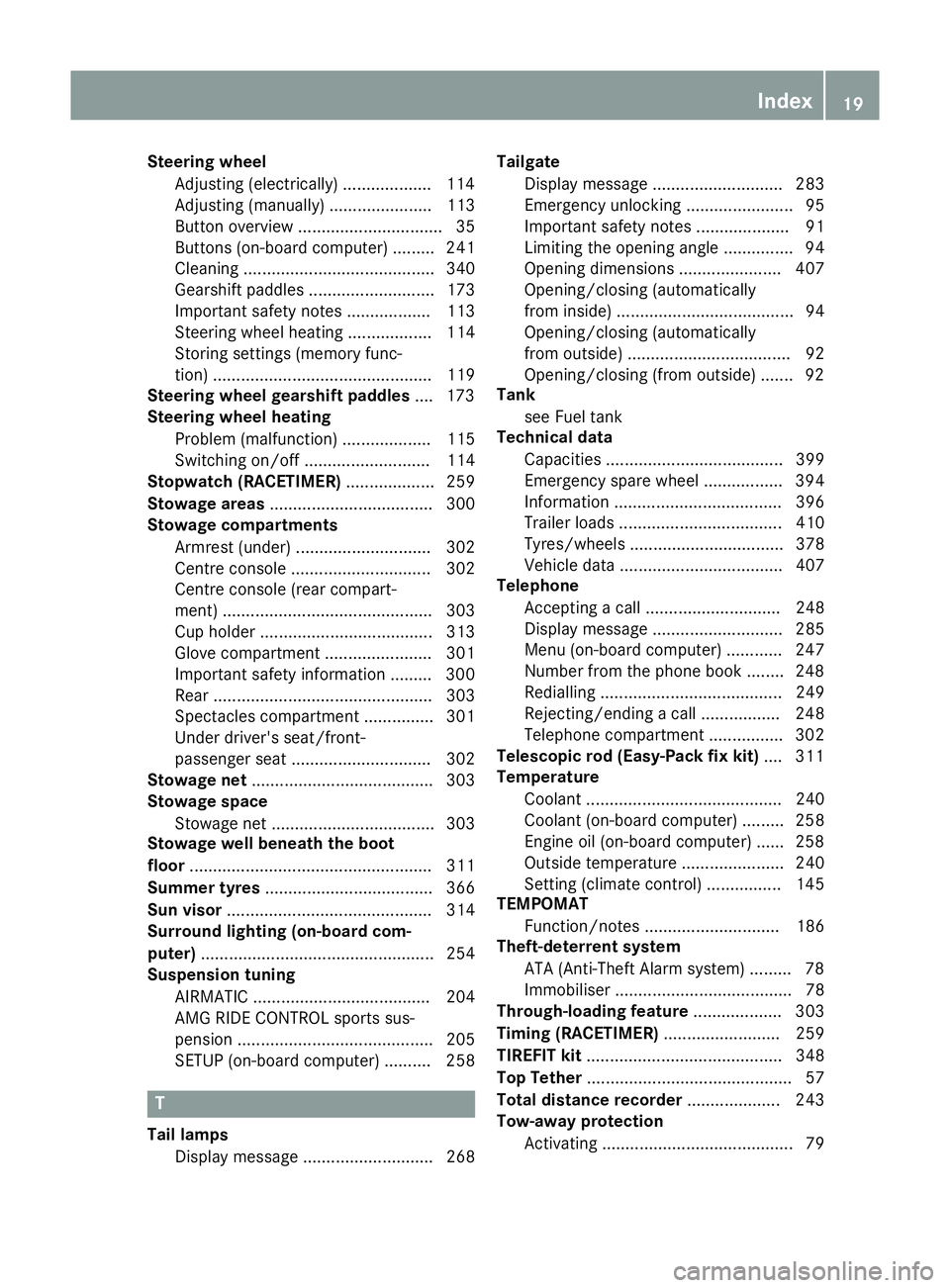
Steering wheel
Adjusting (electrically) ...................1 14
Adjusting (manually) ...................... 113
Button overview ............................... 35
Buttons (on-board computer) ......... 241
Cleaning ......................................... 340
Gearshift paddle s........................... 173
Important safety notes .................. 113
Steering wheel heating .................. 114
Storing settings (memory func-
tion) ............................................... 119
Steering wheel gearshift paddles .... 173
Steering wheel heating
Problem (malfunction) ................... 115
Switching on/of f........................... 114
Stopwatch (RACETIMER) ................... 259
Stowage areas ................................... 300
Stowage compartments
Armrest (under) ............................. 302
Centre console .............................. 302
Centre console (rear compart-
ment) ............................................. 303
Cup holde r..................................... 313
Glove compartment ....................... 301
Important safety information ......... 300
Rear ............................................... 303
Spectacles compartment ............... 301
Under driver's seat/front-
passenger sea t.............................. 302
Stowage net ....................................... 303
Stowage space
Stowage net ................................... 303
Stowage well beneath the boot
floor .................................................... 311
Summer tyres .................................... 366
Sun visor ............................................ 314
Surround lighting (on-board com-
puter) .................................................. 254
Suspension tuning
AIRMATIC ...................................... 204
AMG RIDE CONTROL sports sus-
pension .......................................... 205
SETUP (on-board computer) .......... 258 T
Tail lamps Display message ............................ 268 Tailgate
Display message ............................ 283
Emergency unlocking ....................... 95
Important safety notes .................... 91
Limiting the opening angle ............... 94
Opening dimensions ...................... 407
Opening/closing (automatically
from inside) ...................................... 94
Opening/closing (automatically
from outside) ................................... 92
Opening/closing (from outside) ....... 92
Tank
see Fuel tank
Technical data
Capacities ...................................... 399
Emergency spare wheel ................. 394
Information .................................... 396
Trailer load s................................... 410
Tyres/wheels ................................. 378
Vehicle data ................................... 407
Telephone
Accepting a cal l............................. 248
Display message ............................ 285
Menu (on-board computer) ............ 247
Number from the phone book ........ 248
Redialling ....................................... 249
Rejecting/ending a call ................. 248
Telephone compartment ................ 302
Telescopic rod (Easy-Pack fix kit) .... 311
Temperature
Coolant .......................................... 240
Coolant (on-board computer) ......... 258
Engine oil (on-board computer) ...... 258
Outside temperature ...................... 240
Setting (climate control )................ 145
TEMPOMAT
Function/note s............................. 186
Theft-deterrent system
ATA (Anti-Theft Alarm system )......... 78
Immobiliser ...................................... 78
Through-loading feature ................... 303
Timing (RACETIMER) ......................... 259
TIREFIT kit .......................................... 348
Top Tether ............................................ 57
Total distance recorder .................... 243
Tow-away protection
Activating ......................................... 79 Index
19
Page 135 of 417

R
you drop it
R you scratch it
Only operate bulbs in enclosed lamps
designed for that purpose. Only fit spare
bulbs of the same type and the specified volt- age.
Marks on the glass tube reduce the service
life of the bulbs. Do not touch the glass tube
with your bare hands. If necessary, clean the
glass tube when cold with alcohol or spirit and
rub it off with a lint-free cloth.
Protect bulbs from moisture during opera-
tion. Do not allow bulbs to come into contact
with liquids.
You can neither replace xenon bulbs nor LED bulbs. Have LED bulbs replaced at a qualified
specialist workshop.
Replace only the bulbs listed (Y page 132).
Have the bulbs that you cannot replace your-
self replaced at a qualified specialist work-
shop.
If you require assistance replacing bulbs, con-
sult a qualified specialist workshop.
If the new bulb still does not light up, consult a qualified specialist workshop.
Bulbs and lamps are an important aspect of
vehicle safety. You must therefore make sure
that these function correctly at all times.
Have the headlamp setting checked regularly. Overview of bulb replacement – bulbs
You can replace the following bulbs. The
details for the bulb type can be found in the
legend. Tail lamps
:
Reversing lamp: W 16 W Replacing the rear bulbs
Reversing lamp Lamp cluster
X
Switch off the lights.
X Open the boot or luggage compartment.
X Reach up into the side panelling and pull
downwards until the lamp cluster is easily
accessible.
X Press the detent of connector ;and pull
out connector ;.
X Use a suitable tool to loosen and remove
four nuts :.
X Remove the entire lamp cluster.
X Turn bulb holder =anti-clockwise and pull
it out.
X Pull out the bulb.
X Insert the new bulb into bulb holder =.
X Insert bulb holder =into the lamp and turn
it clockwise. 132
Replacing bulbsLigh
ts and windscreen wipers
Page 349 of 417
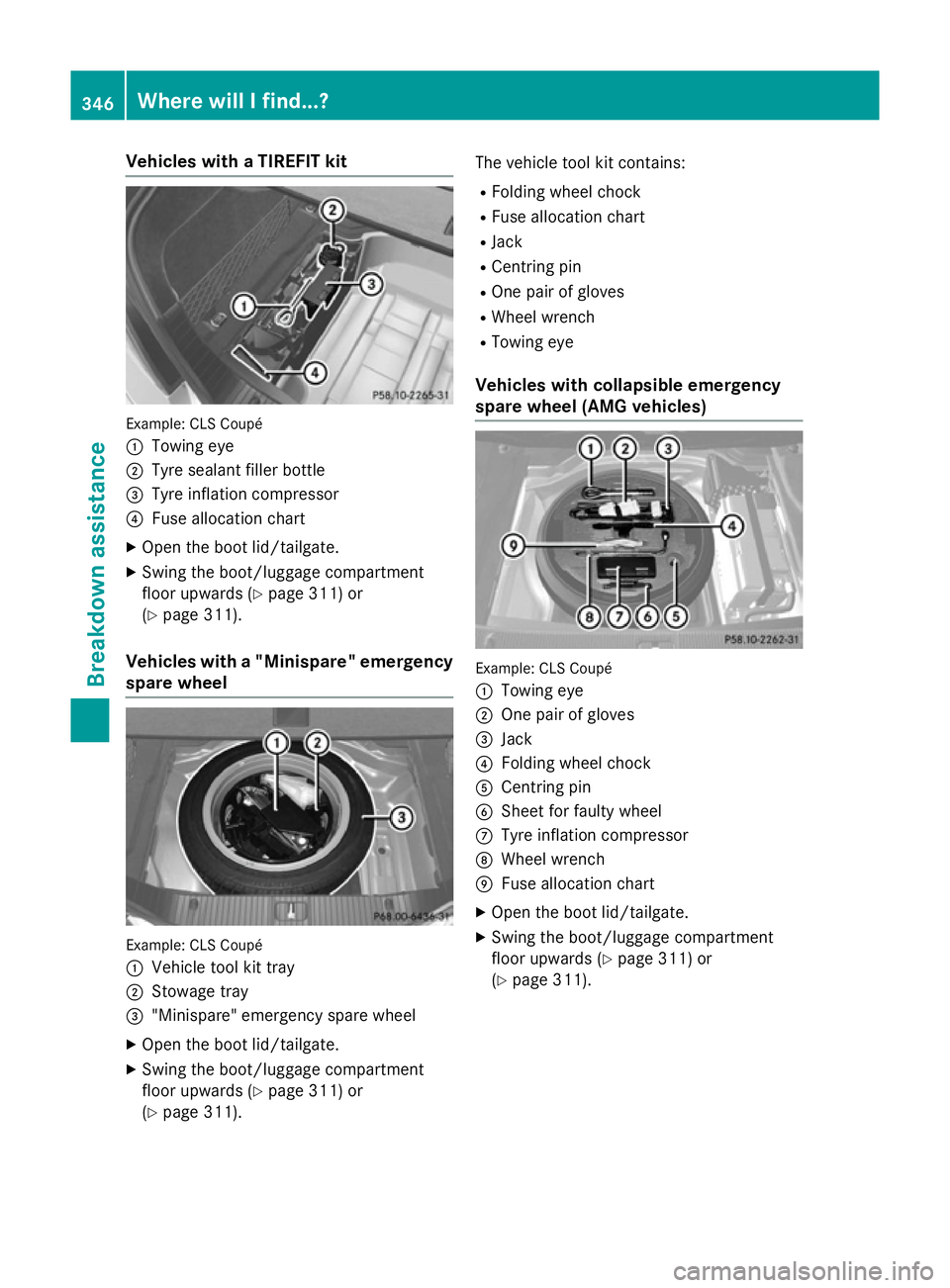
Vehicles with a TIREFIT kit
Example: CLS Coupé
:
Towing eye
; Tyre sealant filler bottle
= Tyre inflation compressor
? Fuse allocation chart
X Open the boot lid/tailgate.
X Swing the boot/luggage compartment
floor upwards (Y page 311) or
(Y page 311).
Vehicles with a "Minispare" emergency
spare wheel Example: CLS Coupé
:
Vehicle tool kit tray
; Stowage tray
= "Minispare" emergency spare wheel
X Open the boot lid/tailgate.
X Swing the boot/luggage compartment
floor upwards (Y page 311) or
(Y page 311). The vehicle tool kit contains:
R Folding wheel chock
R Fuse allocation chart
R Jack
R Centring pin
R One pair of gloves
R Wheel wrench
R Towing eye
Vehicles with collapsible emergency
spare wheel (AMG vehicles) Example: CLS Coupé
:
Towing eye
; One pair of gloves
= Jack
? Folding wheel chock
A Centring pin
B Sheet for faulty wheel
C Tyre inflation compressor
D Wheel wrench
E Fuse allocation chart
X Open the boot lid/tailgate.
X Swing the boot/luggage compartment
floor upwards (Y page 311) or
(Y page 311). 346
Where will I find...?Breakdo
wn assis tance
Page 350 of 417
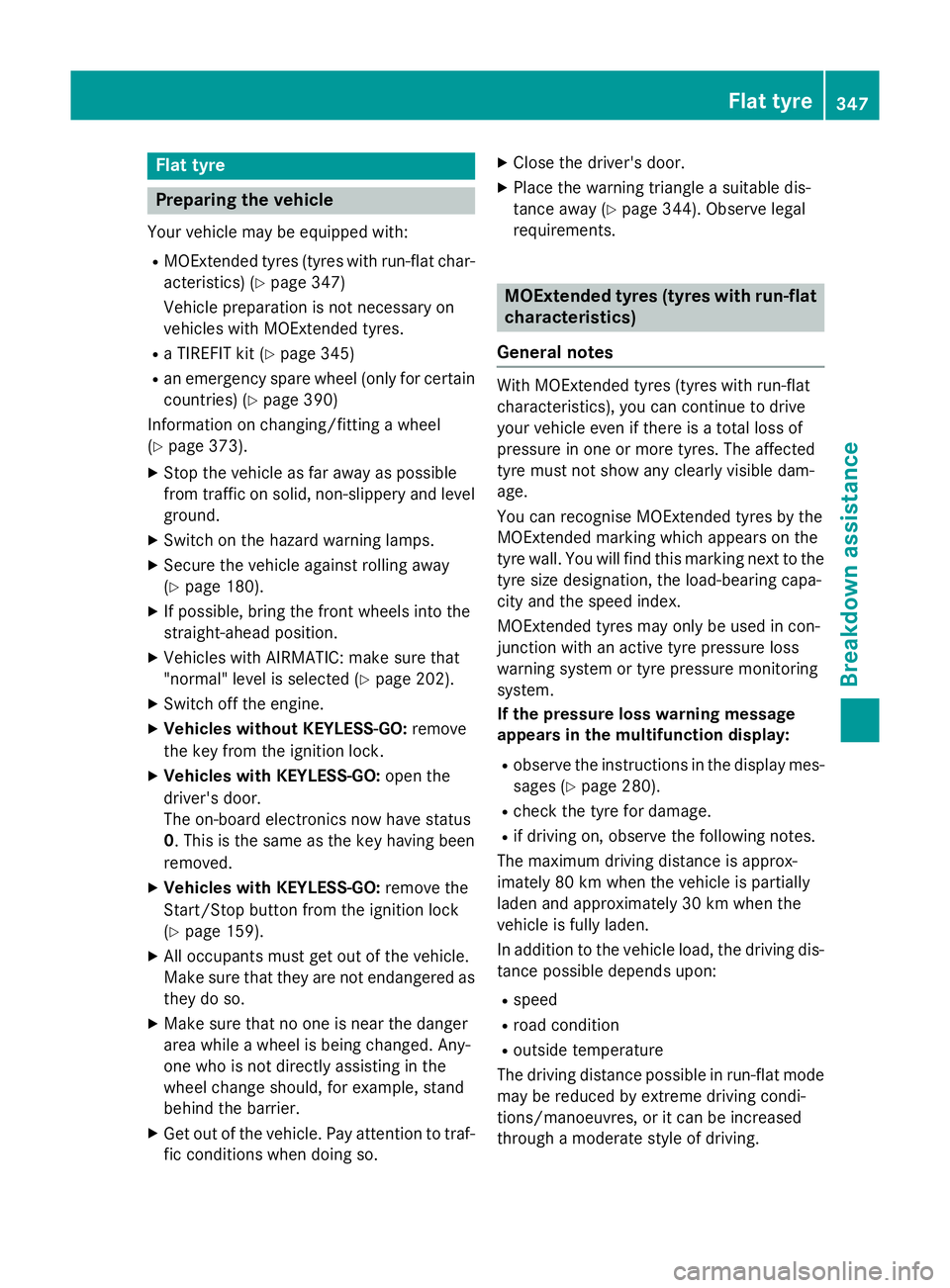
Flat tyre
Preparing the vehicle
Your vehicle may be equipped with: R MOExtended tyres (tyres with run-flat char-
acteristics) (Y page 347)
Vehicle preparation is not necessary on
vehicles with MOExtended tyres.
R a TIREFIT kit (Y page 345)
R an emergency spare wheel (only for certain
countries) (Y page 390)
Information on changing/fitting a wheel
(Y page 373).
X Stop the vehicle as far away as possible
from traffic on solid, non-slippery and level
ground.
X Switch on the hazard warning lamps.
X Secure the vehicle against rolling away
(Y page 180).
X If possible, bring the front wheels into the
straight-ahead position.
X Vehicles with AIRMATIC: make sure that
"normal" level is selected (Y page 202).
X Switch off the engine.
X Vehicles without KEYLESS-GO: remove
the key from the ignition lock.
X Vehicles with KEYLESS-GO: open the
driver's door.
The on-board electronics now have status
0 . This is the same as the key having been
removed.
X Vehicles with KEYLESS-GO: remove the
Start/Stop button from the ignition lock
(Y page 159).
X All occupants must get out of the vehicle.
Make sure that they are not endangered as they do so.
X Make sure that no one is near the danger
area while a wheel is being changed. Any-
one who is not directly assisting in the
wheel change should, for example, stand
behind the barrier.
X Get out of the vehicle. Pay attention to traf-
fic conditions when doing so. X
Close the driver's door.
X Place the warning triangle a suitable dis-
tance away (Y page 344). Observe legal
requirements. MOExtended tyres (tyres with run-flat
characteristics)
General notes With MOExtended tyres (tyres with run-flat
characteristics), you can continue to drive
your vehicle even if there is a total loss of
pressure in one or more tyres. The affected
tyre must not show any clearly visible dam-
age.
You can recognise MOExtended tyres by the
MOExtended marking which appears on the
tyre wall. You will find this marking next to the
tyre size designation, the load-bearing capa-
city and the speed index.
MOExtended tyres may only be used in con-
junction with an active tyre pressure loss
warning system or tyre pressure monitoring
system.
If the pressure loss warning message
appears in the multifunction display:
R observe the instructions in the display mes-
sages (Y page 280).
R check the tyre for damage.
R if driving on, observe the following notes.
The maximum driving distance is approx-
imately 80 km when the vehicle is partially
laden and approximately 30 km when the
vehicle is fully laden.
In addition to the vehicle load, the driving dis- tance possible depends upon:
R speed
R road condition
R outside temperature
The driving distance possible in run-flat mode may be reduced by extreme driving condi-
tions/manoeuvres, or it can be increased
through a moderate style of driving. Flat tyre
347Breakdown assistance
Page 368 of 417
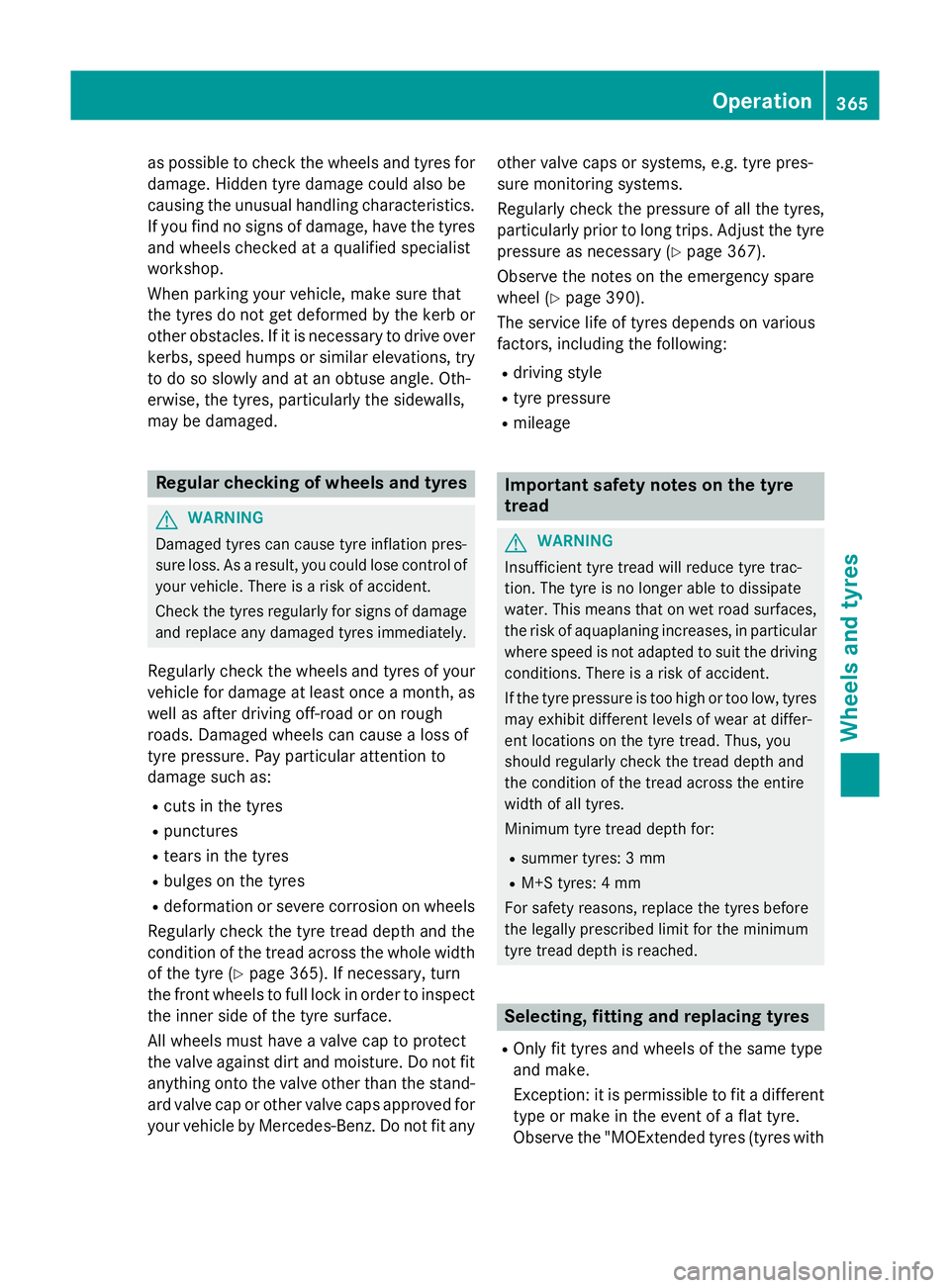
as possible to check the wheels and tyres for
damage. Hidden tyre damage could also be
causing the unusual handling characteristics.
If you find no signs of damage, have the tyres and wheels checked at a qualified specialist
workshop.
When parking your vehicle, make sure that
the tyres do not get deformed by the kerb or
other obstacles. If it is necessary to drive over
kerbs, speed humps or similar elevations, try
to do so slowly and at an obtuse angle. Oth-
erwise, the tyres, particularly the sidewalls,
may be damaged. Regular checking of wheels and tyres
G
WARNING
Damaged tyres can cause tyre inflation pres-
sure loss. As a result, you could lose control of your vehicle. There is a risk of accident.
Check the tyres regularly for signs of damage and replace any damaged tyres immediately.
Regularly check the wheels and tyres of your
vehicle for damage at least once a month, as well as after driving off-road or on rough
roads. Damaged wheels can cause a loss of
tyre pressure. Pay particular attention to
damage such as:
R cuts in the tyres
R punctures
R tears in the tyres
R bulges on the tyres
R deformation or severe corrosion on wheels
Regularly check the tyre tread depth and the condition of the tread across the whole width
of the tyre (Y page 365). If necessary, turn
the front wheels to full lock in order to inspect
the inner side of the tyre surface.
All wheels must have a valve cap to protect
the valve against dirt and moisture. Do not fit
anything onto the valve other than the stand-
ard valve cap or other valve caps approved for
your vehicle by Mercedes-Benz. Do not fit any other valve caps or systems, e.g. tyre pres-
sure monitoring systems.
Regularly check the pressure of all the tyres,
particularly prior to long trips. Adjust the tyre
pressure as necessary (Y page 367).
Observe the notes on the emergency spare
wheel (Y page 390).
The service life of tyres depends on various
factors, including the following:
R driving style
R tyre pressure
R mileage Important safety notes on the tyre
tread
G
WARNING
Insufficient tyre tread will reduce tyre trac-
tion. The tyre is no longer able to dissipate
water. This means that on wet road surfaces, the risk of aquaplaning increases, in particularwhere speed is not adapted to suit the driving
conditions. There is a risk of accident.
If the tyre pressure is too high or too low, tyres may exhibit different levels of wear at differ-
ent locations on the tyre tread. Thus, you
should regularly check the tread depth and
the condition of the tread across the entire
width of all tyres.
Minimum tyre tread depth for:
R summer tyres: 3 mm
R M+S tyres: 4 mm
For safety reasons, replace the tyres before
the legally prescribed limit for the minimum
tyre tread depth is reached. Selecting, fitting and replacing tyres
R Only fit tyres and wheels of the same type
and make.
Exception: it is permissible to fit a different type or make in the event of a flat tyre.
Observe the "MOExtended tyres (tyres with Operation
365Wheels and tyres Z
Page 369 of 417
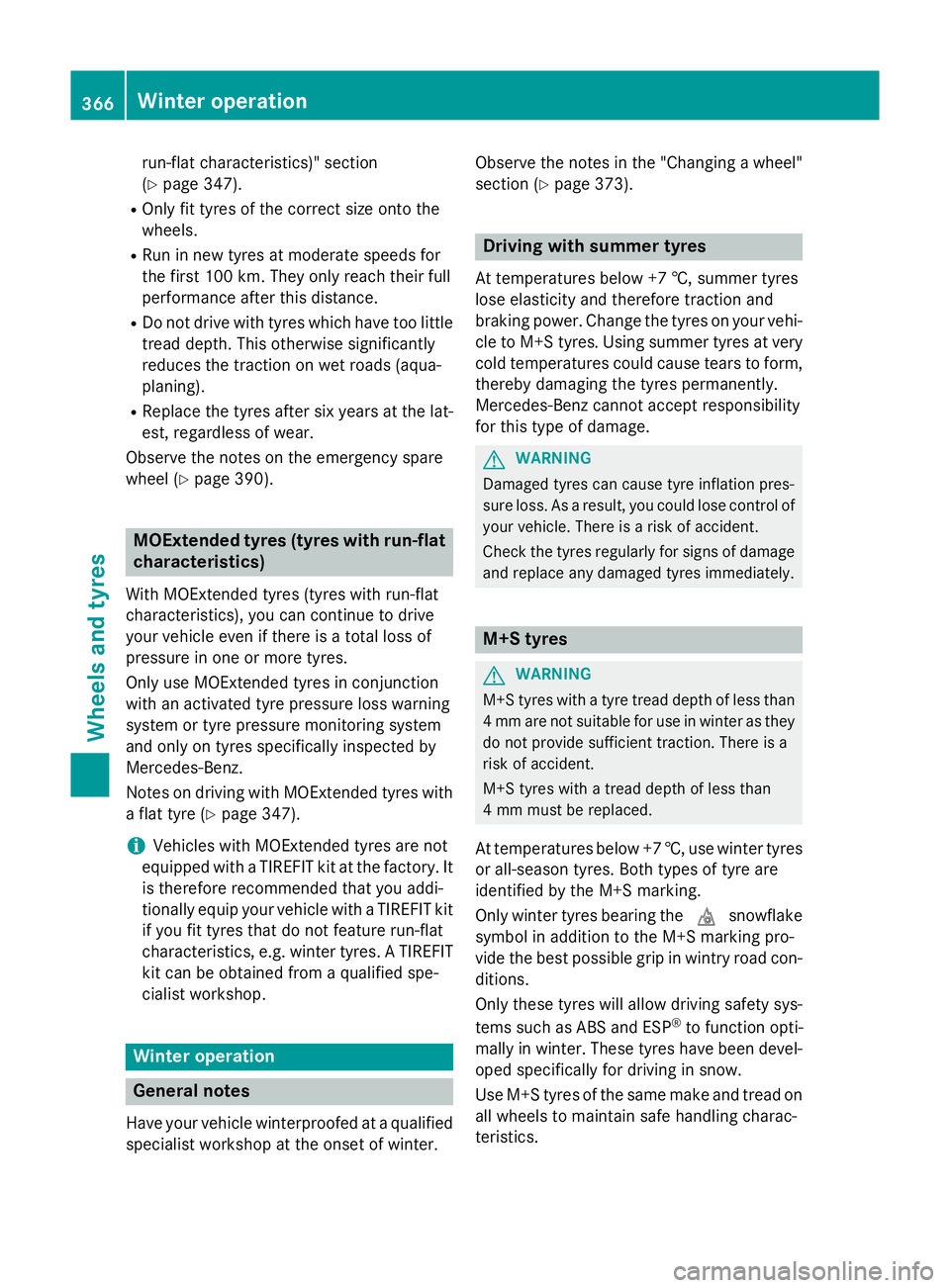
run-flat characteristics)" section
(Y
page 347).
R Only fit tyres of the correct size onto the
wheels.
R Run in new tyres at moderate speeds for
the first 100 km. They only reach their full
performance after this distance.
R Do not drive with tyres which have too little
tread depth. This otherwise significantly
reduces the traction on wet roads (aqua-
planing).
R Replace the tyres after six years at the lat-
est, regardless of wear.
Observe the notes on the emergency spare
wheel (Y page 390). MOExtended tyres (tyres with run-flat
characteristics)
With MOExtended tyres (tyres with run-flat
characteristics), you can continue to drive
your vehicle even if there is a total loss of
pressure in one or more tyres.
Only use MOExtended tyres in conjunction
with an activated tyre pressure loss warning
system or tyre pressure monitoring system
and only on tyres specifically inspected by
Mercedes‑Benz.
Notes on driving with MOExtended tyres with a flat tyre (Y page 347).
i Vehicles with MOExtended tyres are not
equipped with a TIREFIT kit at the factory. It
is therefore recommended that you addi-
tionally equip your vehicle with a TIREFIT kit if you fit tyres that do not feature run-flat
characteristics, e.g. winter tyres. A TIREFIT
kit can be obtained from a qualified spe-
cialist workshop. Winter operation
General notes
Have your vehicle winterproofed at a qualified specialist workshop at the onset of winter. Observe the notes in the "Changing a wheel"
section (Y page 373). Driving with summer tyres
At temperatures below +7 †, summer tyres
lose elasticity and therefore traction and
braking power. Change the tyres on your vehi- cle to M+S tyres. Using summer tyres at very
cold temperatures could cause tears to form, thereby damaging the tyres permanently.
Mercedes-Benz cannot accept responsibility
for this type of damage. G
WARNING
Damaged tyres can cause tyre inflation pres-
sure loss. As a result, you could lose control of your vehicle. There is a risk of accident.
Check the tyres regularly for signs of damageand replace any damaged tyres immediately. M+S tyres
G
WARNING
M+S tyres with a tyre tread depth of less than 4 mm are not suitable for use in winter as they
do not provide sufficient traction. There is a
risk of accident.
M+S tyres with a tread depth of less than
4 mm must be replaced.
At temperatures below +7 †, use winter tyres or all-season tyres. Both types of tyre are
identified by the M+S marking.
Only winter tyres bearing the isnowflake
symbol in addition to the M+S marking pro-
vide the best possible grip in wintry road con- ditions.
Only these tyres will allow driving safety sys-
tems such as ABS and ESP ®
to function opti-
mally in winter. These tyres have been devel-
oped specifically for driving in snow.
Use M+S tyres of the same make and tread on all wheels to maintain safe handling charac-
teristics. 366
Winter operationWheels and tyres